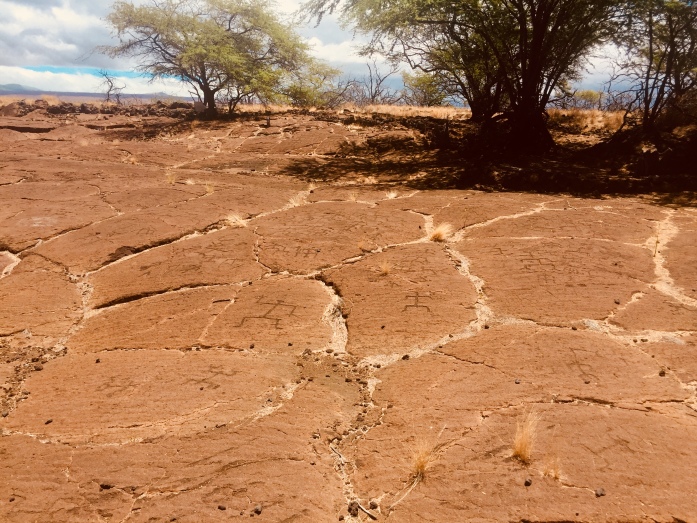Classic Rocks

We had a vehicle and we wanted to use it – but we also didn’t want to spend all of our time driving. There had been many incredible suggestions of places to explore, but we decided to stick close to Kailua-Kona and see what the coastline had to offer us.
The western coast of the island is made up of mostly volcanic shores, and the sandy beaches are generally a bit of a walk away from where a vehicle can take you. After having just worked like crazy to save for travel, sort out leaving our country and planned overseas wedding, relaxing on a beach wasn’t high up on our abilities list. As Post Malone says, “Worked so hard forgot how to vacation.” So we were on the hunt for some sort of free adventure.
In the Mauna Lani Resort, near the Fairmont Orchid, about 40 minutes north of Kailua-Kona, lives the historic Puakō Petroglyph Archaelogical District. With over 3000 preserved petroglyphs identified, and 223 acres, it is the largest protected petroglyph site in Hawaii.
What are Petroglyphs?
A petroglyph is a carving or engraving in a rock or stone’s surface, generally by a prehistoric group of people, and are found worldwide.
Petroglyphs do not hold one single meaning or purpose. Dependent on their age, their geographical location and their designs, there can be many different hypotheses on the function of their existence.
Getting There
We followed Google Maps, but even with the GPS navigator, it felt a little bit strange. You drive off of the Queen Ka’ahumanu Highway (19) onto Mauna Lani Drive. There is lots of development and it did not feel like we were in Hawaii anymore – a bit strange seeing as we were headed to a historic petroglyph site.
Once we arrived at the carpark, we saw the ocean and walked straight towards it. That was incorrect – but definitely worth the 5 minutes we spent walking along the shoreline in pursuit of the petroglyphs. We’d recommend having a pitstop in the water AFTER your walk, as it is very hot out there.

As we walked back into the parking lot, about 20m from the beach, we complained about how there was no sign to the petroglyph trail, and how upsetting it was to see all of the development around us. Maybe the petroglyphs were gone? Then, just as we were about to give up, we found the entrance to the Malama Trail, marked with a sign. Good work team.
You’ll know you’re in the right place when you see the resident guard cat in the tree.
The first part of the walk is on a paved trail in direct sunlight and you can see the Fairmont Orchid to your right. You will stumble upon a large group of replica petroglyphs, to help show you what you’re looking for along the trail. There isn’t anything out there to explain that these are replicas – only our research online later told us. I mean, we should’ve known, they’re perfect engravings, but don’t be fooled, it was not prehistoric people who made these ones!
Why We Loved It
The Puakō Petroglyph district held an incredible energy. You could feel that there were many men who walked before us, and the power of the volcanoes that created the terrain.
The walk was 1 1/2 miles and went from volcanic coastline to covered forest to grassy plains to volcanic desert. We kept our eye out for petroglyphs on the walk but didn’t find too many. Then we came to an opening in the trees, we were at the volcanic desert. There was a plane flying overhead when we arrived and it sounded like loud drumming, which made for an extra spiritual moment.

There is a walkway around the petroglyphs to protect them, and there are a few rock and wooden benches around, but they were too hot to sit on. It was incredible how hot it felt out there, only such a short distance from the ocean breeze.
We loved the archaeological honesty, in that they have no idea what these carvings mean, and they are open to interpretation. It gave us the pleasure of using our imaginations and coming up with what each different petroglyph may have meant, or what they meant as a whole.
The idea we loved most: They meant nothing at all. Imagine they are like the piles of rocks people make today, small ones stacked upon bigger ones in mountains or on beaches. They hold no spiritual significance, no religious pleas. They are simply humans being human, playing a game and testing their skills.
And with that hypothesis, we felt closer to the prehistoric people. Appreciating them for communicating with us through time, but understanding them and connecting to them as non-supernatural, human beings.







Loving your blogs! So informative! I am learning something every day! Thank you :)) Looking forward to the next installment!
LikeLike
Thanks so much Nat!! Thanks for reading and supporting us with your love 🙂 xx
LikeLike